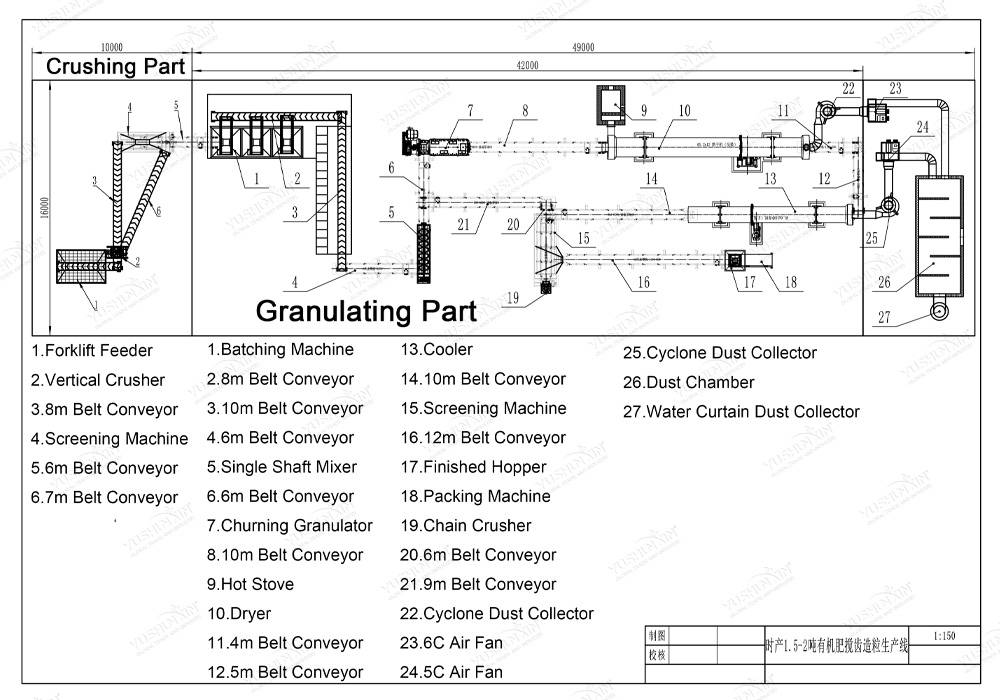







To convert phosphate rock into a usable fertilizer form, acid is required to “acidulate” the rock, which releases soluble phosphorus compounds. Common acids used include:
To create NPK fertilizers, other sources of nitrogen and potassium can be mixed with the phosphate material. Some examples include:
Stroški vsake proizvodne linije se razlikujejo glede na proizvodno zmogljivost, stopnja avtomatizacije, in posebne potrebe. Izpolnite spodnji obrazec in zagotovili vam bomo natančno ponudbo!
Če vas zanima naša oprema za izdelavo gnojil, Prosimo, pošljite svoje zahteve in stike, nato pa vas bomo kontaktirali čez dva dni. Obljubimo, da vsi vaši podatki ne bodo nikomur pritegnjeni.
- Podjetje je bilo ustanovljeno v 2005 in se osredotoča na raziskave in razvoj in proizvodnjo opreme za organska gnojila za 20 leta. Zgradil je 40.000 m obsežne baze za proizvodnjo opreme za organska gnojila, z uporabo napredne granulacije, Tehnologije sušenja in presejanja za izboljšanje učinkovitosti proizvodnje in kakovosti izdelka.
- Samostojno uvozno in izvozno podjetje z več kot 80 Profesionalni inženirji po vsem svetu, služenje več kot 100 države in regije po vsem svetu, 5,000+ Primeri storitve za stranke, 10 centri za predelavo, 3 Laserski stroji za rezanje, in več kot 60 Oprema različnih vrst.
- Ohranjanje dolgoročnega in obsežnega sodelovanja s številnimi znanstvenimi raziskovalnimi inštituti in univerzami, with a professional R&D team, lahko nenehno optimizira uspešnost opreme glede na povpraševanje na trgu.
- Visoko trdni materiali, odporni na obrabo, Carbon Steel Q235/zlitina je izbrana za zagotovitev, da je oprema trpežna in zmanjša stroške vzdrževanja.
- Sprejetje inteligentnih krmilnih sistemov za izboljšanje ravni avtomatizacije proizvodnje in zmanjšanje ročne odvisnosti.
- ISO, Ce, SGS International Certificiranje
- Z obsežno proizvodno zmogljivostjo, lahko ustreza različnim zahtevam proizvodne zmogljivosti (majhno, srednje in velike proizvodne linije).
- Celotna paleta modelov opreme, Primerno za proizvodnjo različnih vrst gnojil, kot je organsko gnojilo, sestavljeno gnojilo, Biološko gnojilo, Vodno topno gnojilo, tekoče gnojilo, itd.
- Prilagojeno oblikovanje je mogoče zagotoviti glede na potrebe strank, vključno s proizvodno zmogljivostjo, Postavitev spletnega mesta, Standardi varstva okolja, itd.
- Zagotoviti celoten nabor rešitev proizvodnih linij, vključno z izbiro opreme, Namestitev in zagon, Tehnično usposabljanje, itd.

- Neposredna tovarniška dobava, Zmanjšanje povezave posrednika, in cena je bolj konkurenčna.
- Oprema ima visoko energetsko učinkovitost, zmanjšuje porabo energije, in strankam pomaga zmanjšati dolgoročne obratovalne stroške.
- Neposredna tovarniška dobava, Zmanjšanje povezave posrednika, in cena je bolj konkurenčna.
- Oprema ima visoko energetsko učinkovitost, zmanjšuje porabo energije, in strankam pomaga zmanjšati dolgoročne obratovalne stroške.
Dobava stroja za poliranje gnojil vodilnemu proizvajalcu gnojil na Nizozemskem
Uspešna dobava 1T/H dvovaljnih granulatorjev strankam v Turčiji in Združenem kraljestvu
Učinkovita rešitev za obračanje komposta, dostavljena filipinskemu naročniku
Uspešna dobava diskastega granulatorja čilskemu naročniku za proizvodnjo gnojil
Povečanje učinkovitosti peletiranja za skupino GoodEarth, Južna Afrika